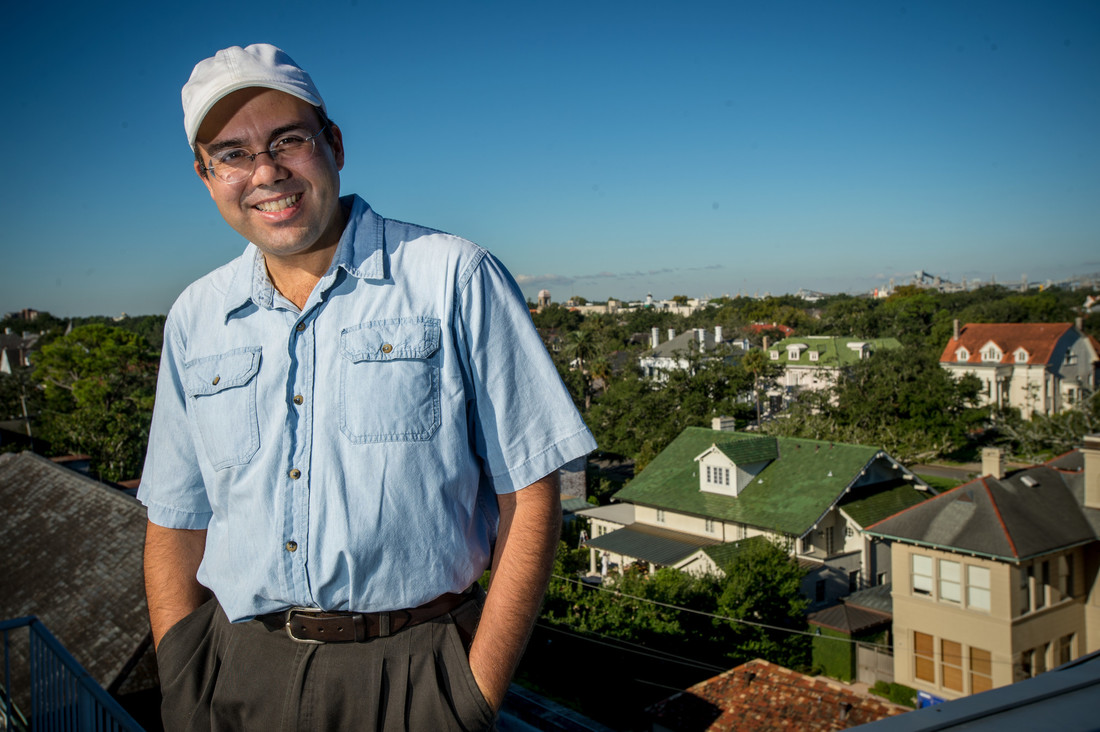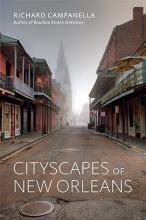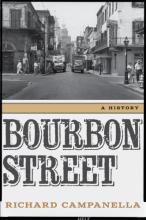Richard Campanella
Associate Dean for Research, Senior Professor of Practice - Architecture and Geography

Areas of Expertise
Biography
Geographer Richard Campanella, Senior Professor of Practice with the Tulane School of Architecture, is the author of ten books and over 200 other publications on New Orleans and Louisiana geography, history, architecture, urbanism, culture and related topics. His research has been praised in the New York Review of Books, Journal of Southern History, Places Journal, Urban History, Louisiana History, Journal of the Abraham Lincoln Association, and Bloomsbury Review.
The only two-time winner of the Louisiana Endowment for the Humanities Book of the Year Award, Campanella has also received the Louisiana Literary Award, The Historic New Orleans Collection’s Williams Prize for Louisiana History, the Newcomb Mortar Board Award for Excellence in Teaching, the Monroe Fellowship of the New Orleans Center for the Gulf South, the Hannah Arendt Prize for Scholarship in the Public Interest, the Tulane University Honors Professor of the Year Award, and the Press Club of New Orleans award for digital videos on Louisiana geography. In 2016, the Government of France named Campanella as Chevalier dans l’Ordre des Palmes Académiques (Knight in the Order of the Academic Palms).
Born in Brooklyn, N.Y., Campanella is a former wilderness ranger with the U.S. Forest Service and a forestry volunteer with the U.S. Peace Corps in Honduras. He has worked at Tulane since 2000 and the School of Architecture since 2012. He lives uptown with his wife Marina and son Jason.
As a geographer, Campanella researches questions of “where” and “why there.” That is, he tries to identify, characterize, and explain spatial patterns—of human settlement, the built environment, and the underlying physical geography—with an emphasis on New Orleans and Louisiana. His approach is empirical and quantitative, using mapping and spatial analysis tools such as Geographic Information Systems (GIS) and remote sensing, integrated with qualitative sources and humanistic methods.
Curiosity about place and people, past and present, drives what his work and he loves sharing his findings—through books, articles, three monthly writing commitments with regional publications, frequent public lectures, online at richcampanella.com, and most importantly, with Tulane students, who over the years have selected him three times for Excellence in Teaching / Professor of the Year awards.
Education
Louisiana State University
Utah State University
Accomplishments
Louisiana Endowment for the Humanities Book of the Year Award
Richard Campanella is a two-time winner of the Louisiana Endowment for the Humanities Book of the Year Award.
The Historic New Orleans Collection’s Williams Prize for Louisiana History
Richard Campanella is the winner of a Historic New Orleans Collection’s Williams Prize for Louisiana History.
Links
Articles
From Landmark to Parking Lot: The Original Temple Sinai Endured for 105 Years
2018
For just over a century, a striking Byzantine temple dominated the skyline of the transitional zone between downtown and uptown New Orleans. Its construction marked a significant transformation within a local religious community, while its demolition reflected the uptown residential shift of that population. The building was the original Temple Sinai, and it stood on Carondelet Street, between Howard Avenue and Calliope Street, from 1872 to 1977.
Straight Streets in a Curvaceous Crescent: Colonial Urban Planning and Its Impact on Modern New Orleans
2018
New Orleans is justly famous for its vast inventory of historical architecture, representing scores of stylistic influences dating to the French and Spanish colonial eras. Less appreciated is the fact that the Crescent City also retains nearly original colonial urban designs. Two downtown neighborhoods, the French Quarter and Central Business District, are entirely undergirded by colonial-era
planning, and dozens of other neighborhoods followed suit even after Americanization. New Orleanians who reside in these areas negotiate these colonial planning decisions in nearly every movement they make, and they reside in a state with as many colonial-era land surveying systems as can be found throughout the United States. This article explains how those patterns fell in place.
Walking In New Orleans
2018
A change is afoot in the streets of New Orleans—literally.
There’s no pat term for it. It’s tough to measure. We miss it when it disappears, and encourage its return. It ranks among the most basic and important elements of city life. It’s people in the public space: pedestrians, stoop-sitters, flâneurs, window-shoppers, cyclists, dog walkers, joggers, chess players in the park, children at the playground—folks outside, interacting, participating in this thing we call city life.
Hazard experience, geophysical vulnerability, and flood risk perceptions in a postdisaster city, the case of New Orleans
2017
This article investigates the determinants of flood risk perceptions in New Orleans, Louisiana (United States), a deltaic coastal city highly vulnerable to seasonal nuisance flooding and hurricane‐induced deluges and storm surges. Few studies have investigated the influence of hazard experience, geophysical vulnerability (hazard proximity), and risk perceptions in cities undergoing postdisaster recovery and rebuilding. We use ordinal logistic regression techniques to analyze experiential, geophysical, and sociodemographic variables derived from a survey of 384 residents in seven neighborhoods. We find that residents living in neighborhoods that flooded during Hurricane Katrina exhibit higher levels of perceived risk than those residents living in neighborhoods that did not flood. In addition, findings suggest that flood risk perception is positively associated with female gender, lower income, and direct flood experiences. In conclusion, we discuss the implications of these findings for theoretical and empirical research on environmental risk, flood risk communication strategies, and flood hazards planning.
14 to 1: Post-Katrina Architecture by the Numbers
2016
Last year the world media converged noisily on New Orleans to mark the tenth anniversary of Hurricane Katrina. This year marked a quieter but still significant milestone: it’s been a decade since the actual start of the structural recovery, which began tentatively in early 2006. So this is an apt moment to assess the results. How have the citizens of New Orleans been choosing to rebuild their residences? What do the reconstituted cityscapes look like? What do the choices reveal about the various homeowners, builders, developers, architects, authorities involved—and most of all, about New Orleans society?
These fundamental questions have gone curiously unaddressed in the substantial and growing archive of post-Katrina literature. In general this literature, from scholarship to the trade press to ambitious long-form journalism, falls into three main categories:(1) theoretical discourses on the philosophies that ought to (or ought not) inform the rebuilding, including sustainability, resilience, localism, historicism, modernism, equity, social justice, gentrification, neoliberalism, entrepreneurism, tactical urbanism, New Urbanism, and landscape urbanism;(2) critical analyses of official plans and programs (such as the Bring New Orleans Back Commission and Louisiana Road Home), of the privatization of public housing and hospitals, flood control and insurance, coastal restoration, various recovery schemes, and urban planning in general; and (3) journalistic stories of innovative initiatives and proactive citizen engagement, usually with an eye toward the above narratives.
Media Appearances
Richard Campanella takes a tour of New Orleans' 'Cityscapes
When Richard Campanella releases a new book, the citizens of New Orleans take note.
A geographer with the Tulane University School of Architecture, Campanella has penned a total of 10 well-received books since 1999, when he and his wife, Marina, wrote “New Orleans Then and Now."
His newest publication, “Cityscapes of New Orleans” (LSU Press, October 2017) is a collection of columns written for the local website nola.com|The Times-Picayune, as well as others he has written for the Preservation Resource Center’s monthly, Preservation in Print, and the Louisiana Endowment for the Humanities’ quarterly, Cultural Vistas....
Tricentennial Reading List (New Orleans Streets) with Sally Asher (Part 2)
Campanella's research is always so interesting because he will take maps or take geography and take data that you don't think about or don't consider and put it into a way that makes you view things from a different light. That's always been one of my favorite treats of his. He took Judith Schafer, who was one of my favorite historians, who wrote a lot about-- She wrote all about the brothels and prostitutes, pre- Storyville, mostly in Antebellum era. He took and mapped the different, say, sex crimes that were done and created maps of different areas of high-profile brothels and explain why these were important and why these were here and what that meant.
A tribute to New Orleans from a local who really knows it
Bourbon Street is our most famous name and, “for better or worse, has exported a vision of New Orleans culture around the world,” wrote Richard Campanella, a geographer at Tulane’s School of Architecture who has authored 10 books about New Orleans and Louisiana...
New Orleans celebrates 300 years of letting the good times roll
“It’s a very strategic site for a city,” said Richard Campanella, a geographer and professor at the Tulane School of Architecture. “It made sense at the time.”
I met Campanella in his office, where he rattled off a whiplash version of the city’s history. The French ran New Orleans till the 1760s, followed by the Spanish (1762-1800), then back to the French. In the early 1800s, President Thomas Jefferson expressed interest in purchasing New Orleans. Napoleon, distracted by a slave uprising in Saint-Domingue (now Haiti) and tensions with England, sold Louisiana for $15 million. In 1803, the countries signed the Louisiana Purchase, and the rest is U.S. history.
“This was the dawn of the American Era and the Antebellum Age,” Campanella said...
New Orleans’s Lower Garden District is a preservationist paradise
As New Orleans scholar Richard Campanella points out, there has be an increase of white residents and a decrease of black residents across an area he coins as the White Teapot. The teapot-shaped section of New Orleans, along its river neighborhoods, holds a considerable chunk of the city’s white population. Since 2000, the Lower Garden District has seen an increase of white residents and a decrease of black residents.
Tulane Today Mentions
The Best Bank? West Bank an essential part of NOLA, says Tulane professor
Tulane geographer and author wins Louisiana Writer Award
Tulane ByWater Institute awards faculty fellowships
African-Americans in New Orleans face rigged real estate market, report says
Tulane experts chime in on Mardi Gras cleanup and a major Mayan discovery
A grand marshal, a Carnival queen and a krewe of skeletons
Health, heroes and the #MeToo movement
Tricentennial book explores New Orleans’ global impact
Tricentennial book reflects on New Orleans’ ‘First 300 Years’
Tulane geographer to discuss formation of New Orleans’ neighborhoods
In the News
The Wall Street Journal: New Orleans Needs an Economic Win. It’s Betting on the Super Bowl.
Nola.com: Amid a global supply chain crisis, how New Orleans’ port has avoided major shipping delays
New Orleans' $15 billion levee held. But another problem looms, experts say.
AP News: New Orleans-area film, TV studio buys old Ford building
Nola.com: Whatever became of the 'lost bayous' of New Orleans? Waterways once laced the metro area
National Geographic: New Orleans’ historic architecture is uniquely suited to pandemic living
New York Times: Flood and Sacrifice: How an Old Convent Could Help Save New Orleans









